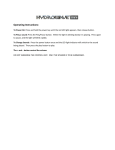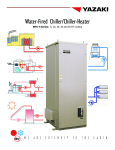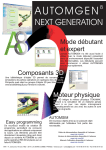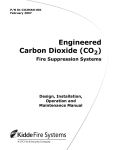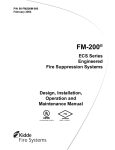Download Fire extinguishers exposed to Flood Conditions
Transcript
Fire Extinguishers Exposed to Flood Conditions By J. R. Nerat Occasionally spring weather and storm conditions can expose installed fire extinguishers to flood conditions. When fire extinguishers are known or suspected of having been exposed to submerged conditions there are several special servicerelated items to consider before attempting to place these units back into service. The existing ANSI/UL fire extinguisher standards incorporate various forms of hardware exposure tests like ultraviolet light, salt spray, vibration, impact, abrasion, and elevated temperatures to obtain product approvals, which are specifically designed to address most normally anticipated outdoor exposure conditions. While listed fire extinguishers are designed and tested to withstand a variety of such conditions, submerged water exposure over various periods of time can present problematic situations requiring some extra attention during equipment examinations. Submerged water exposure over various periods of time can present problematic situations requiring some extra attention during equipment examinations. Whenever a fire extinguisher is suspected of having been subjected to conditions which might impair its operational integrity such as being submerged in a flood, it should be removed from service and subjected to a thorough maintenance [ 10 ] FIREWATCH! June 2014 examination in accordance with NFPA 10 and the appropriate service manual recommendations. It is especially important to ensure that only properly trained and qualified personnel perform such examinations. This is necessary, as personnel must be specifically familiar with the functional limitations and acceptable tolerances of all applicable hardware components. While there are various equipment hardware design characteristics that can dictate special examination considerations, the following list attempts to highlight some of the most applicable. • Thoroughly rinse and wash fire extinguisher exterior surfaces to remove any residual mud, dirt, salt, or foreign residues. Avoid the use of commercial degreasers, solvents, or strong detergents. Warm fresh water and mild soap are typically recommended. Compressed air can be used to help clear small accumulations of debris and help dry surfaces. • Perform a thorough visual external examination of the unit, paying special attention for any dents or impact damage which might have occurred. Ensure handles, levers, rivets, and ring pins are not bent, deformed, or corroded. • Ensure there are no signs of foreign material or corrosion present behind potentially hidden cylinder areas like hose bands, nameplates, and any protective bottom enclosures. • During the various disassembly steps identified within service manual procedures, pay special attention to any open valve or safety relief port areas to ensure no foreign material or corrosion is present. • Gasket and o-ring surfaces should be wiped clean and examined closely for any damage. Prior to re-assembly they should then be lightly lubricated with the recommended lubricant identified within the service manual to avoid compromising material compounds. • All hose assemblies and nozzles should be closely examined to ensure no residue or obstructions are present. Coupling areas should not exhibit any separation, cracks, damage, or corrosion. Interior and exterior hose assembly surfaces should also be properly dried prior to re-assembly. • If the extinguishing agent charge is suspected of being compromised or directly exposed to water, a proper internal examination and recharge should be performed in accordance with service manual recommendations. • Pressure gauge housing and faces should be closely examined for any potential damage and to ensure no water or debris has entered. If such conditions are observed, the pressure gauge should be replaced following the service manual’s recommendations. • Wheels should be properly examined and re-lubricated as necessary. • Regulators and connection hardware should all be visually examined closely for any damage and to ensure no water or foreign material is present. Regulators should be tested for proper static dead set pressure and minimum flow characteristics per service manual recommendations. Pressure regulators exhibiting any problems must be replaced, as no adjustments or disassembly is permitted. Anytime unusual circumstances or conditions are observed, service personnel should always consult with the fire equipment manufacturer for guidance and specific recommendations. v Copyright © 2014 by J.R. Nerat, all rights reserved. J. R. Nerat is the technical manager for Badger/Kidde Fire Protection. [ 12 ] FIREWATCH! June 2014


